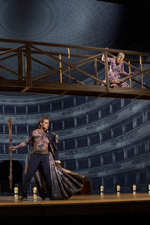> [Archived] Chronicles

The Tempest by Thomas Ades - The MET: Live in HD
Who is Thomas Adès?
Conductor and pianist born in London in 1971, Thomas Adès is nowadays one of the most respected contemporary musicians. The list of his musical compositions is consistent and includes symphonic, chamber and choral works, a violin concerto and, up to now, two operas. Each first audition was acclaimed by the public and unanimously appreciated by the specialists. Thomas Adès is a Professor of Composition at the Royal Academy of Music in London, he was given an honorary doctorate granted by the University of Essex in 2004 and he is also a member of the Royal Swedish Academy of Music. Between 1998 and 2000 he was the Music Director of the Birmingham Contemporary Music Group and during 1999-2008 he was the Artistic Director of the Aldeburgh Festival.
The Tempest by Thomas Adès
The Tempest is his second opera. In the libretto created by Meredith Oakes, she deliberately avoided the original text, but in exchange she kept the story and especially the fairy-tale atmosphere of the charmed island lost at sea, inhabited by people, wizards and spirits and where, in a confined space, imagination is boundless and what happens influences the history of European states and dynasties. The libretto is written in verse, more precisely in the often-naïve quatrains that make you think of children's nursery rhymes. There are fairy-tale characters and the fight between good and evil, ending, like in all fairy-tales, with the triumph of the good, the truth and, most of all, the pure love of two young people. We may hear an atmospheric music, which is descriptive and suggestive - from the deadly storm to the lyrical love moments, from the coarse comicality of the drunkards to Ariel's vocal and gestural acrobatics - that accompanies and efficiently supports the alert story. The composer conducting his own work is certainly an interesting event. Each character`s sonorous universe has a definite shape. The score still bears Benjamin Britten's imprint, but it's not disturbing. Thomas Adès's sonorous and multi-coloured edifice is built on tradition, but with a refined and striking personal touch - I mainly refer here to Ariel's part, which, being dedicated to a coloratura soprano with a high vocal register, manages to musically suggest the acrobatic and sometimes desperate flight of a chained spirit, longing for freedom.
Comments on the production
There were few people at The Light Cinema on Saturday evening, 10th November, 2012! It is rather unexplainable when the broadcast performance from the MET has Robert Lepage as stage manager. He is the one who amazed and delighted us with his fantastic version of the tetralogy Der Ring des Nibelungen, also presented at the MET over the past seasons. This time, too, Robert Lepage doesn't disappoint us and I dare say that he can take the credit for at least half of the huge public acclaim. For The Tempest Lepage created the same scenery, but using different versions and various symbols for the three sections of the work: in the first act, when those being on the island witness the tragedy at sea, the decor mirrors the stage and the hall at the MET; in the second act, when the survivors play the parts set by Prospero, the stage becomes the decor of an Elizabethan play, from the candles in the foreground to the traditional tricks which are specific to the theatre of that period; in the final act, the mirrored reflection of the stage and the hall at the MET is used again, but this time the space is divided so that, each character can become in turn both actor and spectator.
The costumes (Kym Barrett) are full of imagination, colour and fantasy and they are not changed during the entire performance. The only exception is Prospero`s: at the beginning he appears heavily tattooed on his chest and arms and half-naked, the other half being covered by his dishevelled duke's cape. In the final act, Prospero only keeps the feathers, adorning his head, like a savage's ornament, whereas his whole body is now clad in a tunic with epaulets and decorations that are appropriate for a true leader.
On the artists
As always, only praises for the artists' singing and acting: Simon Keenlyside (Prospero) was amazing, with a dense and tensioned score and a part that kept him on stage most of the time; Audrey Luna (Ariel) was spectacular, with vocal and acting performances that shared the acrobatics; Isabel Leonard (Miranda) and Alek Shrader (Ferdinand), sweet and poetical as befits an honest and naive young couple in love; Alan Oke (Caliban), tragic and comic at the same time, was impeccable. The cast also included Iestyn Davies, William Burden, Toby Spence, as well as the members of the MET's choir and ballet.
Few people at The Light Cinema on Saturday evening, 10th November, 2012, to see The Tempest, an opera in three acts, composed by the British Thomas Adès, based on a libretto inspired by Shakespeare's homonymous play; it was a live broadcast from the Metropolitan Opera House in New York! What a pity!
Translated by Mihaela Olinescu and Alinda-Gabriela Ivanov and Elena Daniela Radu
MTTLC, Bucharest University














